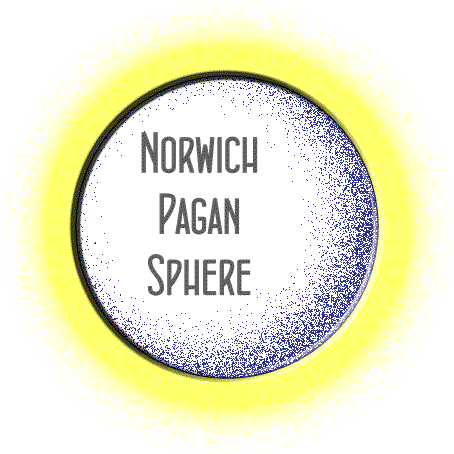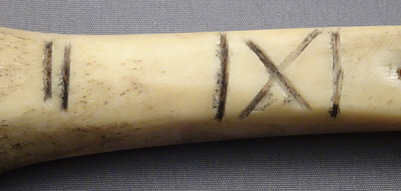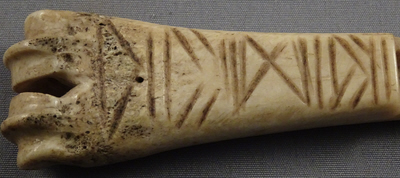
Brought to you by
Norwich Pagan Sphere

 |
Brought to you by
|

Scoops carved from the metapodial (lower leg) bones of sheep seem to have served several purposes, removing the cores from apples, sampling cheeses, as eating utensils for those afflicted by tooth loss, and as love tokens cut, carved and given by young men to their sweethearts in a manner similar to Welsh Love Spoons (Macgregor, 1985, p. 180).
In all probability, they served many purposes, rather than a single one, and they may well have been carved accordingly. Little work has been done to analyse staining and wear marks to elucidate actual use, but where it has, the implications can be significant, as with similar tools found in London that appear in fact to be fids for rope working (Stokes, 2016).
The scoop on this example does not appear long enough to remove an apple core, and indeed Dorothy Hartley illustrates one with a longer, flatter end (Hartley, 1954, p. 416). The standard of carving varies tremendously, with some very ornate examples rivalling Love Spoons, whereas this scoop has been carved relatively crudely, surely as a work-a-day tool, and has the patina and wear of use.

Similarly, the decoration seems perfunctory, the bare minimum expected perhaps in the tradition perceived by its carver, although the grooves have been blackened to show up better. The potential significance of the decoration is discussed below.

This example is more carefully carved, with an expertly defined scoop. Its intended or actual use may have been different to that of the first example above, but the patina of use is again present.
Whilst it has no firm provenance, this scoop is believed to have been made by a French prisoner of war interned in the Norman Cross Depot (Huntingdonshire) that existing during the Napoleonic Wars (1797-1814). Bone scoops were indeed a common product made by skilled PoWs in the depots for sale to local people, although it is the ornate bone and straw work that is most prized (it is indeed exquisite), rather than these humble objects (Lloyd, 2007).

As very personal utensils, whether in daily use by the same hand or a special token of romance, these bone scoops exude an additional, subtle patina. They seem to reach out as if their long-gone owners still hold them. That is a kind of magic in itself.
However, the decoration is significant as well. The commonest carved motif is a cross (X) mark between vertical lines, as in the two examples illustrated here. For some it may have been simply the traditional decoration, or even part of an identification mark, but others will have carved it with deeper intent and received the gift with understanding.
The earliest securely dated examples of bone scoops of this kind are from the 17th century, perhaps reflecting greater availability of suitable fine-toothed saws, which prove to be essential for cutting the bone (Smaldon, 2002; Stokes, 2016). This gives some context to the decoration.
The dating would seem to rule out any direct link to Germanic runes, for instance, although both gyfu (gift) and dagaz (day) may well lie in the background, as the precursor to the use of the X as a symbol of a kiss (gyfu) and as the likely precursor to German and Dutch shutter decoration (dagaz). (See Pennick (2015) for more on Runic sumbolism.)
The single | X | marks on bone scoops have generally been seen as wishes for good luck, quite appropriate to an object that might be given to one's sweetheart. In other contexts, however, the mark may have the purpose of barring entry, direct blessing or (on church door metalwork) possibly marking the space as Christ's. For more on these marks, see Wood (2019).